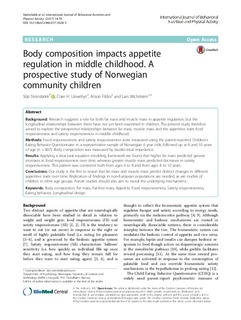| dc.contributor.author | Steinsbekk, Silje | |
| dc.contributor.author | Llewellyn, Clare H | |
| dc.contributor.author | Fildes, Alison | |
| dc.contributor.author | Wichstrøm, Lars | |
| dc.date.accessioned | 2017-12-13T07:15:29Z | |
| dc.date.available | 2017-12-13T07:15:29Z | |
| dc.date.created | 2017-08-03T14:10:24Z | |
| dc.date.issued | 2017 | |
| dc.identifier.issn | 1479-5868 | |
| dc.identifier.uri | http://hdl.handle.net/11250/2470921 | |
| dc.description.abstract | Background
Research suggests a role for both fat mass and muscle mass in appetite regulation, but the longitudinal relationships between them have not yet been examined in children. The present study therefore aimed to explore the prospective relationships between fat mass, muscle mass and the appetitive traits food responsiveness and satiety responsiveness in middle childhood.
Methods
Food responsiveness and satiety responsiveness were measured using the parent-reported Children’s Eating Behavior Questionnaire in a representative sample of Norwegian 6 year olds, followed up at 8 and 10 years of age (n = 807). Body composition was measured by bioelectrical impedance.
Results
Applying a structural equation modeling framework we found that higher fat mass predicted greater increases in food responsiveness over time, whereas greater muscle mass predicted decreases in satiety responsiveness. This pattern was consistent both from ages 6 to 8 and from ages 8 to 10 years.
Conclusions
Our study is the first to reveal that fat mass and muscle mass predict distinct changes in different appetitive traits over time. Replication of findings in non-European populations are needed, as are studies of children in other age groups. Future studies should also aim to reveal the underlying mechanisms. | nb_NO |
| dc.language.iso | eng | nb_NO |
| dc.publisher | BioMed Central | nb_NO |
| dc.rights | Navngivelse 4.0 Internasjonal | * |
| dc.rights.uri | http://creativecommons.org/licenses/by/4.0/deed.no | * |
| dc.title | Body composition impacts appetite regulation in middle childhood. A prospective study of Norwegian community children | nb_NO |
| dc.type | Journal article | nb_NO |
| dc.type | Peer reviewed | nb_NO |
| dc.description.version | publishedVersion | nb_NO |
| dc.source.volume | 14 | nb_NO |
| dc.source.journal | International Journal of Behavioral Nutrition and Physical Activity | nb_NO |
| dc.source.issue | 1 | nb_NO |
| dc.identifier.doi | 10.1186/s12966-017-0528-5 | |
| dc.identifier.cristin | 1484021 | |
| dc.description.localcode | © The Author(s). 2017. This article is distributed under the terms of the Creative Commons Attribution 4.0 International License (http://creativecommons.org/licenses/by/4.0/), which permits unrestricted use, distribution, and reproduction in any medium, provided you give appropriate credit to the original author(s) and the source, provide a link tothe Creative Commons license, and indicate if changes were made. The Creative Commons Public Domain Dedication waiver(http:// creativecommons.org/publicdomain/zero/1.0/) applies to the data made available in this article, unless otherwise stated. | nb_NO |
| cristin.unitcode | 194,67,40,0 | |
| cristin.unitname | Institutt for psykologi | |
| cristin.ispublished | true | |
| cristin.fulltext | original | |
| cristin.qualitycode | 2 | |

